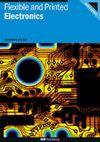Wear reliability and failure mechanism of inkjet-printed conductors on paperboard substrate
IF 3.2
4区 工程技术
Q3 MATERIALS SCIENCE, MULTIDISCIPLINARY
引用次数: 0
Abstract
In this research, we conducted a wear test on inkjet-printed silver conductors using different loads and counter materials (two paperboards, brushed steel sheet, and sandpaper) with similar surface roughness values. The conductor’s reliability was characterized by resistance measurement, the failures and tested counter materials were analyzed using an optical microscope, profilometer, scanning electron microscope, and energy dispersive spectrometer. It was found that the counter material has a dominant impact on a conductor’s reliability and failure mechanism compared with load. The conductors were exceptionally reliable but subject to adhesive wear when tested by paperboards. They were also highly reliable when tested by brushed steel sheet although the silver became severely detached, and the conductivity was lost suddenly when a major scratch was caused by two-body and three-body abrasive wear mechanisms. Sandpaper rubbing caused the most severe silver detachment and quick loss of conductivity, as a large amount of small-size (5–15 µm) silicon carbide particles with sharp edges and corners caused a dense cutting effect via two-body abrasive wear (by cutting) mechanism. Additionally, the failures in almost all samples occurred in the areas in contact with the counter edges, suggesting that failure was accelerated by the edge effect. This study proves that inkjet-printed electronics on the investigated paperboard is exceptionally durable when rubbed by paperboards and steel sheets, and thus provides a reliable solution to intelligent packaging. To promote intelligent packaging, more paperboards, as well as approaches for reducing the edge effect can be investigated.纸板基板喷墨印刷导体磨损可靠性及失效机理
在这项研究中,我们使用不同的负载和表面粗糙度值相似的反材料(两块纸板、拉丝钢板和砂纸)对喷墨印刷银导体进行了磨损测试。通过电阻测量表征了导体的可靠性,使用光学显微镜、轮廓仪、扫描电子显微镜和能量色散光谱仪分析了故障和测试的反材料。研究发现,与负载相比,反材料对导体的可靠性和失效机制具有主要影响。这些导体非常可靠,但在用纸板测试时会出现粘着磨损。当用拉丝钢板进行测试时,它们也是高度可靠的,尽管银变得严重脱落,并且当由三体和三体磨料磨损机制引起重大划痕时,导电性突然丧失。砂纸摩擦导致了最严重的银分离和导电性的快速损失,因为大量具有尖锐棱角的小尺寸(5–15µm)碳化硅颗粒通过两体磨料磨损(通过切割)机制产生了密集的切割效果。此外,几乎所有样品的失效都发生在与反边缘接触的区域,这表明边缘效应加速了失效。这项研究证明,在所研究的纸板上喷墨打印的电子产品在被纸板和钢板摩擦时格外耐用,从而为智能包装提供了可靠的解决方案。为了促进智能包装,可以研究更多的纸板以及减少边缘效应的方法。
本文章由计算机程序翻译,如有差异,请以英文原文为准。
求助全文
约1分钟内获得全文
求助全文
来源期刊

Flexible and Printed Electronics
MATERIALS SCIENCE, MULTIDISCIPLINARY-
CiteScore
4.80
自引率
9.70%
发文量
101
期刊介绍:
Flexible and Printed Electronics is a multidisciplinary journal publishing cutting edge research articles on electronics that can be either flexible, plastic, stretchable, conformable or printed. Research related to electronic materials, manufacturing techniques, components or systems which meets any one (or more) of the above criteria is suitable for publication in the journal. Subjects included in the journal range from flexible materials and printing techniques, design or modelling of electrical systems and components, advanced fabrication methods and bioelectronics, to the properties of devices and end user applications.
 求助内容:
求助内容: 应助结果提醒方式:
应助结果提醒方式:


